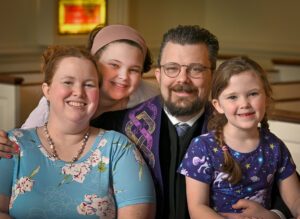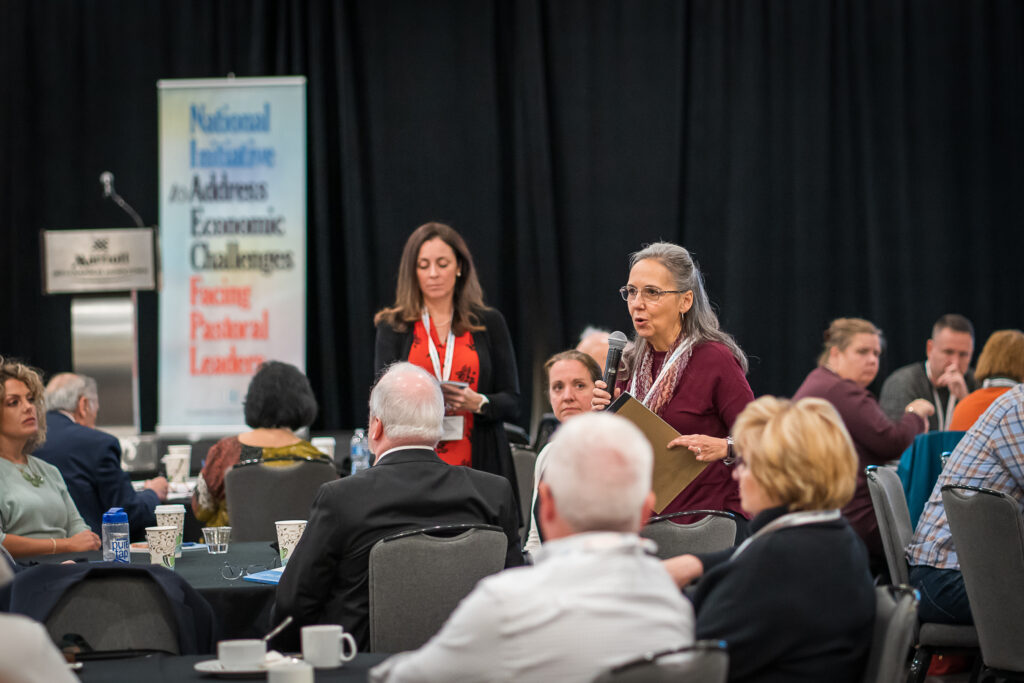2022 Annual Report:
Planning helps organizations identify financial needs of
pastors and congregations.
The Rev. Matthew Baker can’t remember the exact date that he was awarded the $10,000 that would change his family’s finances and his ministry as a congregational pastor. But six years later, he easily remembers the flood of emotion that followed.
“Relief,” he recalls. “Just such a feeling of relief.”
It was a feeling made possible because of support from Healthy Pastors, Healthy Congregations, a program launched as a pilot in 2016 by The Board of Pensions of the Presbyterian Church (U.S.A.) and then expanded nationally in 2018.

Healthy Pastors, Healthy Congregations offered Baker (left), then pastor of a small congregation in central North Carolina, a $10,000 grant that he could use to pay down personal debt or to save for retirement. The program also provided personal financial counseling and a course focused on church finances and congregational leadership.
“My wife and I had two young children and two car payments. We used the money from the Healthy Pastors program to help pay off one of the vehicles and lowered our monthly debt,” Baker says. “That was just a phenomenal help to my family and to my ability to lead as a pastor.”
Baker was one of more than 944 pastors in the Presbyterian Church (U.S.A.)—PC(USA)—who participated in Healthy Pastors, Healthy Congregations between 2016 and 2022. The program provided more than $8.3 million in direct aid to pastors, thanks in part to funding and encouragement from Lilly Endowment’s National Initiative to Address Economic Challenges Facing Pastoral Leaders (National Initiative).
The Endowment designed the initiative to help church-related institutions—especially denominational judicatories, foundations and pension and benefits boards—understand the financial pressures their pastors face and develop approaches to help pastors address those challenges so that they are better able to lead their congregations effectively and to continue their call to serve God. Through several rounds of grantmaking in the National Initiative, the Endowment made planning and implementation grants to organizations to assist them in designing and launching programs for pastors. After their programs demonstrated their effectiveness, many participating organizations received additional grants to sustain and extend the reach of programs.
Time to dream and learn
When the initiative began in 2015, planning grants helped 22 church-related organizations to engage in research to learn more about the most pressing financial challenges faced by pastors and their families and then to consider strategies to help pastors address them. That’s how PC(USA)’s Board of Pensions worked to identify financial stressors experienced by their pastors and began to design Healthy Pastors, Healthy Congregations.
“We were not previously aware of the scope of the issue, that so many pastors were struggling with debt,” says Andy Browne, senior vice president of Church Engagement for the Board of Pensions, who oversaw Healthy Pastors, Healthy Congregations from 2016 through 2021.
Like many other organizations participating in the Endowment’s National Initiative, the Board of Pensions heard stories from pastors who carried excessive student loan debt from seminary or even undergraduate education for decades into their careers. They learned about midcareer pastors struggling with financial challenges as they raised families and older pastors worried about underfunded retirement savings. Pastors at all stages of life reported being unable to meet financial emergencies, such as unexpected medical bills.
The Endowment planning grant offered “time to dream about what we could do,” Browne says. “With time for planning, we were able to think much bigger.”
Understanding the unique financial stressors of pastors
In 2016, Baker had been ordained for just a few years and was serving his first congregation at Macedonia Presbyterian Church in Candor (below), a small town 80 miles east of Charlotte. Money was very tight as Baker and his wife were starting a family on a single income.

“You just cannot live on one pastor’s income and be in the middle class, even if you try very hard to keep your expenses as low as possible,” says Baker.
The relationship between money and congregations and their pastors can be tricky—and always humbling, Baker says. “Every Sunday, you pass the plate around and in the back of your mind, you think about the fact that the money collected is part of what helps put food on our table at home,” he says.
Pastors and church leaders recognize that many Americans share similar financial stressors. Yet pastors’ circumstances are unique in some ways. Often they invest in higher-than-average levels of education—doctoral degrees are common—but earnings rarely come close to those of professions with similar degree requirements. Most U.S. pastors are not mega-church ministers but are more likely to serve small- and medium-sized congregations that typically pay modest salaries, with equally modest or even non-existent employee benefits.
Pastors also are assumed to be answering a call from God and to “be in the world, but not of the world.” It can be difficult to have honest conversations within the church about compensation and the financial challenges that pastors face. While many pastors struggle with their own finances, they are expected to teach about Christian stewardship and generosity and to lead congregational fundraising campaigns.
Leaders of PC(USA)’s Board of Pensions recognized that these circumstances generated tensions for pastors about their own finances. “To borrow language from the Endowment’s initiative, there is a culture of shame and blame around debt for too many of our ministers,” Browne says. “They had internalized the issue of debt and did not talk about it, until someone asked.”
From planning to pilot program
Drawing on insights from the planning process, the Board of Pensions started small. It identified North Carolina as the best location to launch a pilot project with the support of a $1 million implementation grant. For the pilot, it selected five areas—called presbyteries—that included large and small congregations in both rural and urban settings that reflected the diversity of Black, white and Hispanic members.
The board then adopted a dual action plan. It offered pastors direct aid and support to improve their financial well-being; and it approached congregational lay leaders with information about why their pastors struggle financially and what role the church can play in understanding and alleviating financial pain.
At first, pastors were slow to sign up, even with the offer of $10,000 in debt relief or support for their retirement savings. But as word of the program spread and Healthy Pastors, Healthy Congregations built credibility, “it snowballed,” Browne says.
Leaders of the pilot project benefited from participation in annual gatherings that brought together grantees in the National Initiative to exchange insights. At a first year gathering, the Board of Pensions learned from a Catholic diocese about Ernst & Young Employee Financial Services. Through engagement with services like these, Healthy Pastors, Healthy Congregations clergy could receive online financial education and personal financial counseling.
“That was a game changer,” Browne says. “It is an example of how it really mattered to have a new set of colleagues doing the same kind of work.”

A gathering of grantees in the National Initiative to Address Economic Challenges Facing Pastoral Leaders
For pastors to qualify for direct aid, leaders from their congregations needed to be involved in the educational programming with their pastors. Congregations were also asked to make financial contributions to Healthy Pastors, Healthy Congregations. During the past seven years, more than 4,000 PC(USA) pastors and congregational leaders have participated in program activities, which were guided by scripture—Micah 6:8: “He has shown you, O mortal, what is good. And what does the Lord require of you? To act justly and love mercy and walk humbly with your God.”
“We wanted congregational leadership to really consider what it means to be a just and merciful employer, as well as understand the call of their pastors and the financial realities of that call,” Browne says.
Reaching more pastors, building momentum
The pilot’s success in North Carolina led the Endowment to award PC(USA)’s Board of Pensions a second $1 million grant in 2018 to expand the program nationally. The board also invested $4 million from other sources to expand its Ministerial Excellence Fund, which provided direct financial aid to clergy to pay down educational debt, establish savings plans for the educational needs of their children, and incentivize pastors’ full participation in PC(USA) pension programs.
According to the Board of Pensions, Healthy Pastors, Healthy Congregations has changed how the denomination approaches the topic of ministry and money, and it has evolved into two separate programs:
- The Minister Debt Relief program, which the board supports fully through its own resources, continues to provide grants to alleviate pastors’ debts and provide personal and congregational financial education.
- The Minister Educational Debt Assistance program, which is being supported by an additional 2021 Endowment grant to extend the reach of its support of pastors, focuses on the seminary and undergraduate student debt of pastors who receive modest compensations from their congregations.
Ruth Adams, who directs the assistance program at the Board of Pensions, says that the organization continues to draw on the lessons learned through all phases of the grant funding process. For example, language and cultural barriers made it difficult for Korean and Spanish-speaking pastors to fully access the debt relief and financial education resources. In the last three years of the program, the Board of Pensions has taken steps to remove those barriers and make it more inclusive, according to Adams.
“That was the ongoing gift of the planning grant, that each year that we ran this program, we made it better,” she says. “It really changed the conversation at the Board of Pensions and how we approach financial health and wellness for our pastors, who are able to see some light at the end of the tunnel and can focus on ministry. Our congregations have a happier, healthier pastor.”
Baker, who is now pastor of First Presbyterian Church of Rocky Mount, North Carolina, says Healthy Pastors, Healthy Congregations provided a lifeline when he needed it and the tools to plan for a financial future. But it also had a positive influence on his life as a pastor. Educational workshops within his congregation helped lay leaders learn about pastor compensation, how tax law affects clergy, and the importance of healthy communication between pastors and the lay people who help run congregations. Baker says, “It changed the way we talked about clergy compensation for the better.”
Although money is still sometimes tight for his family, his experience with Healthy Pastors, Healthy Congregations affirmed Baker’s calling to congregational ministry.
“I do enjoy being a Presbyterian minister, and I really can’t imagine doing anything else,” he says. “I’ve always felt seen and loved by my denomination, but this is one of the most concrete examples of that love.”
Through the National Initiative to Address Economic Challenges Facing Pastoral Leaders, Lilly Endowment has made grants to 53 organizations to support efforts to reduce or alleviate some of the key financial pressures that impair the abilities of pastors to lead congregations effectively. The organizations also guide pastors through wide-ranging educational programs to improve financial literacy and management skills.